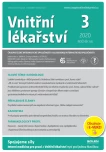Stress kardiomyopathy triggered by unusual situation
Authors:
Katarína Bobocká 1; O. Ga Jurkovičová 1; Branislav Líška 2; Slavomíra Filipová 3
Authors‘ workplace:
IV. interná klinika LF UK a UN Bratislava, Slovenská republika
1; Oddelenie akútnej kardiológie – koronárnej starostlivosti, Národný ústav srdcových a cievnych chorôb, a. s., Bratislava, Slovenská republika
2; Klinika kardiológie a angiológie LF SZU Bratislava a Národného ústavu srdcových a cievnych chorôb, a. s., Bratislava, Slovenská republika
3
Published in:
Vnitř Lék 2020; 66(3): 65-70
Category:
Case Report
Overview
Stress – “takotsubo” cardiomyopathy – is a reversible mimicking acute myocardial infarction. The trigger is extreme mental or physical stress. The main diagnostic examination is ventriculography with typical left ventricle apical ballooning wall motion abnormality. We present a case report of 63 years old woman, hospitalized at the Department of IV. internal Clinic Medical Faculty and University Hospital Bratislava due to angina. The main trigger was atypical stress situation – urgent need to urinate. On admission, the patient’s condition was dominated by the hypertension emergency, tachycardia and psychic tension. The ECG on admission revealed the sinus tachycardia and only marked ST elevation in leads I, II, V3-V6. The negative T wave in the leads I, II, V1-V6 was documented on latter ECG. Following the dynamics of troponin levels we assumed the non-STEMI, but due to psychic stress we also considered stress cardiomyopathy. Our patient underwent the coronary angiography and only marginal changes were present. The catecholamine cardiomyopathy with left ventricular apical wall motion abnormality, mild reduction of ejection fraction (48-50 %) and 1st degree of diastolic dysfunction was proved by ventriculography and echocardiography. After the 2 months follow-up, echocardiography confirmed the physiologic finding. This case report points out to the atypical urgent situation that provoked the stress cardiomyopathy.
Keywords:
acute myocardial infarction – catecholamine cardiomyopathy – left ventricular apical ballooning dysfunction – stress cardiomyopathy – „takotsubo“ cardiomyopathy
Sources
1. Sato H Tako -tsubo -like left ventricular dysfunction due to multivessel coronary spasm. In: Kodama K, Haze K, Hori M (eds.) Clinical Aspect of Myocardial Injury: From Ischemia to Heart Failure. Tokyo: Kagakuhyoronsha Publishing Co 1990, 56–64.
2. Pavin D, Le Breton H, Daubert C Human stress cardiomyopathy mimicking acute myocardial syndrome. Heart 1997; 78: 509–511.
3. Sharkey SW, Shear W, Hodges M et al. Reversible myocardial contraction abnormalities in patients with an acute noncardiac illness. Chest 1998; 114: 98–105.
4. Dúbrava J Tranzitórna apikálna balónová dysfunkcia ľavej komory – syndróm imitujúci akútny infarkt myokardu. Cardiol 2005; 14: 92–96.
5. Paleček T, Linhart A, Jansa P et al. Takotsubo kardiomyopatie: popis případu a přehled literatury. Čas Lék Čes 2005; 144: 406–408.
6. Templin C, Ghadri JR, Diekmann J et al. Clinical features and outcomes of takotsubo (stress) cardiomyopathy. N Engl J Med 2015; 373: 929–938.
7. Chams S, Sayegh SE, Hamdon M et al. Zumba -induced Takotsubo cardiomyopathy: a case report. Journal of Medical Case Reports 2018; 12: 160.
8. Bybee KA, Kara T, Prasad A et al. Systematic review: transient left ventricular apical ballooning: a syndrome that mimics ST -segment elevation myocardial infarction. Ann Intern Med 2004; 141: 858–865.
9. Suzuki H, Matsumoto Y, Kaneta T et al. Evidence for Brain Activation in Patients with Takotsubo Cardiomyopathy. Circ J 2014; 78: 256–258.
10. Ghadri JG, Wittstein IS, Prasad A et al. International Expert Consensus Document on Takotsubo Syndrome (Part I): Clinical Characteristics, Diagnostic Criteria, and Pathophysiology. European Heart Journal 2018; 39: 2032–2046.
11. Bill V, El -Battrawy I, Schramm K et al. Coincidental coronary artery disease impairs outcome in patients with takotsubo cardiomyopathy. QJM: An International Journal of Medicine 2017; 32: 483–488.
12. Ghadri JR, Cammann VL, Jurisic S et al. A novel clinical score (InterTAK Diagnostic Score) to differentiate takotsubo syndrome from acute coronary syndrome: results from the International Takotsubo Registry. Eur J of Heart Fail 2017; 19: 1036–1042.
13. Tamis -Holland JE, Jneid H, Reynolds HR, et al. Contemporary Diagnosis and Management of Patients With Myocardial Infarction in the Absence of Obstructive Coronary Artery Disease: A Scientific Statement From the American Heart Association. Circulation 2019; 139: e891–e908.
14. Kubena P, Bohatá Š, Maňoušek J et al. Takotsubo kardiomyopatie, klinické zkušenosti s onemocnením a jednoletá prognóza pacientů. Vnitř Lék 2015; 61: 619–625.
15. Fröhlich GM, Schoch B, Schmid F et al. Takotsubo cardiomyopathy has a unique cardiac biomarker profile: NT -proBNP/myoglobin and NT -proBNP/troponin T ratios for the differential diagnosis of acute coronary syndromes and stress induced cardiomyopathy. Int J Cardiol 2012; 154: 328–332.
16. Nguyen TH, Neil CJ, Sverdlov AL et al. N -terminal pro -brain natriuretic protein levels in takotsubo cardiomyopathy. Am J Cardiol 2011; 108: 1316–1321.
17. Lyon AL, Bossone E, Schneider B et al. Current state of knowledge on Takotsubo syndrome: a position statement from the task force on Takotsubo syndrome of the Heart Failure Association of the European Society of Cardiology. European Journal of Heart Failure 2016; 18: 8–27.
18. Eitel I, Knobelsdorf -Brenkenhoff F, Bernhardt P et al. Clinical Characteristics and Cardiovascular Magnetic Resonance Findings in Stress (Takotsubo) Cardiomyopathy. JAMA 2011; 306: 277–286.
19. Babický M, Holm F, Erbrt M Takotsubo syndrom: incidencia, etiologie, komplikace, léčba a prognóza. Vnitř Lék 2016; 62: 1021–1027.
20. Citro R, Rigo F, D’Andrea A et al. Echocardiographic correlates of acute heart failure, cardiogenic shock, and in -hospital mortality in tako -tsubo cardiomyopathy. JACC Cardiovasc Imaging 2014; 7: 119–129.
21. Redfors B, Vedad R, Angerås O et al. Mortality in takotsubo syndrome is similar to mortality in myocardial infarction - A report from the SWEDEHEART1registry. Int J Cardiol 2015; 185: 282–289.
22. Pelliccia F, Pasceri V, Patti G et al. Long -term prognosis and outcome predictors in takotsubo syndrome: A systematic review and meta -regression study. JACC Heart Fail 2019; 7: 143–154.
Labels
Diabetology Endocrinology Internal medicineArticle was published in
Internal Medicine

2020 Issue 3
Most read in this issue
- Local thrombolysis for deep vein thrombosis: why, for whom and how?
- What is hiden behind autoinflammation?
- Proteinuria from an internist‘s point of view
- Hepatorenal syndrome – update 2020
